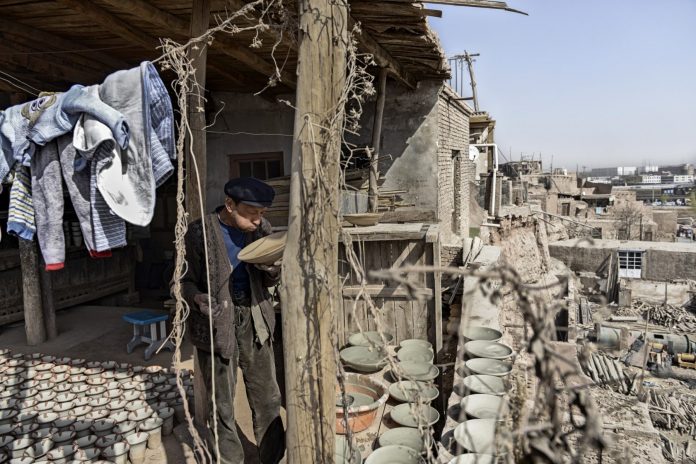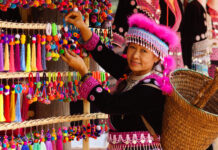
Kashgar as a key point in China’s ambitious plan
Text Zigor Aldama
Oval faces and almond eyes characteristic of the ethnic Han Chinese people are hardly seen in this oasis city at the northwestern tip of the country, located almost 4,000 kilometres from Beijing. Belonging to the Uyghur ethnic minority, the people of Kashgar are of Turkic origin, following the Islamic faith and with Central Asian physical features.
Even the curved roofs and bright colours of Chinese traditional buildings are hardly seen here. The lands of Xinjiang Uyghur Autonomous Region are ochre – the brown tones of wood and mud developing since the year 200. It was precisely the booming silk trade in China that fuelled the building of this fascinating ancient city known as Kashgar, once a cultural pillar of Central Asia and a key point in the legendary Silk Road.

A Commercial Artery
Today, the Chinese government is looking to revive the ancient commercial artery as a way of expanding its influence across the region. The China-Pakistan Economic Corridor has been created for this and its construction is already underway. At a cost of $46 billion, the ambitious 3,000-kilometre project was launched in 2015 to link western China to southern Pakistan through a network of roads, railways and pipelines. The first phase of this mega network is planned to connect Kashgar all the way to Gwadar, a southern port city in Pakistan that overlooks the Arabian Sea.
Known as the “One Belt, One Road” (OBOR) initiative, it consists two commercial routes following the ancient Silk Road – one on land and one on sea. The land belt is known as the Silk Road Economic Belt, and it stretches all the way from the Chinese city of Xi’an to Italy through Central Asia and the Middle East. The sea belt is known as the 21st Century Maritime Silk Road, and it aims to connect the port city of Fuzhou to Europe via Southeast Asia, India and Africa.
According to the Asian Development Bank, the infrastructure proposed for this project involves 60 countries and eight trillion dollars of investment. A huge amount will be partly financed by the recently-created Asian Infrastructure Investment Bank in which China holds the biggest stake.
As in two millennia ago, the routes of Inner Mongolia and Xinjiang will be key points. This time, it would not be the camels riding the Silk Road, but high-speed trains and modern trucks.

Western Economic Zone
‘We have Shenzhen in southern China, and now Kashgar in the west’ are the words of a faded wall panel in Kashgar, referring to the new Special Economic Zone that Beijing has established to attract new investment. The plan is to grant subsidies and tax exemption to companies who choose to establish themselves here. Cheap labour also abounds in the west, in stark contrast with the continuous wage hikes in the highly-developed east coast of China. The same strategy was used to transform the small fishing village of Shenzhen into the economic powerhouse that it is today – all in just over 20 years.
“The Chinese government is well aware of the socio-economic disparities that the 35 years of development, reform and opening up of policies have created,” explains Xu Anqi, Professor of Sociology at Shanghai’s Fudan University. “And that is precisely why they have created the new Silk Road. They intend to narrow the development gap between the east and west and to lessen the urban-rural divide. This, they believe, will provide stability and lower the rate of rural migration.”
Professor Xu adds: “The government also believes that the new Silk Road will enhance the harmony between the Han Chinese majority and ethnic minorities like the Uyghur. OBOR will revive the northwest region, allowing it to regain the geopolitical prominence it once had. The influx of investment and companies will also help to tap into the rich resources of Xinjiang.”
Re-shaping a City
But it is not only the economy that the authorities are interested in, but a re-settlement of the local population in an effort to weed out separatists. Kashgar and Xinjiang’s capital, Urumqi, have long been a troubled area in the Autonomous Region. Extremist Uyghur groups have resorted to terrorism to seek independence in the past. In 2009, riots in Urumqi left close to 200 people dead, and in 2011, a series of knife and bomb attacks led to 23 deaths in Kashgar itself.
A development plan was swiftly approved by the authorities, which came to the conclusion that the ancient city did not meet safety standards regarding earthquakes and fires. Thus, a total five million square metres of new flats would re-house 200,000 people. Over 85% of the 65,000 families living in old houses will be re-located to these new blocks.
“The living conditions in old houses were horrible and posed a grave danger in case of fire,” says an official of the Urban Planning Bureau, who wished to remain anonymous. Others have declined to comment due to the sensitivity of the issue.
“Both Uyghur separatists and the foreign media have criticised the plan, saying it will destroy one of the pillars of Uyghur culture. But we believe the new designs are respectful of the original layout and will generate income through tourism,” the official adds.
Resident Ehmed Rahshid agrees. Newly relocated, he claims that the living conditions of his family have substantially improved. “Before, we did not even have in-house toilets or running water. Now it is all much more comfortable,” he says. Rahshid has made efforts to make sure that his new concrete home looks like the one before that was made of mud. “Because more tourists come now, our income has increased,” he adds.

Preserving the Uyghur Culture
Indeed, the new buildings keep their ochre façade, with some even using the original hardware on doors, windows and balconies. At a distance it is hard to tell the difference, but up close it is clear that workers are not craftsmen, and the details vary from the old buildings. In fact, the new streets bear little resemblance to the ancient ones, which can still be visited near Donghu Lake.
There, Arzu is one of the few residents refusing to leave his mud home. “The Chinese want to turn this into a theme park, something they’ve already done with other ancient cities across the country. They even charge tourists to enter, as if we were specimens in a zoo. Some are happy about the extra income, but I refuse to allow a place where my ancestors have lived to become a huge shopping mall where local residents have to flee. This is the best remaining example of our culture, and I think we should preserve it, not destroy it.”
Arzu is not the only unhappy one. Outside of China, the OBOR initiative has received its fair share of criticism. Experts consulted by the Society for Threatened Peoples have even casted doubt on the accuracy of the technical reasons given by the authorities.
“In Kashgar, earthquakes have occurred for centuries, the last one being in 2004. No building from the old town has ever collapsed. In addition, mud allows houses to remain cool in the summer and warm in the winter. They are of a much higher quality than those made of bricks and mortar,” says Wu Dianting, Professor of Geography at Peking University.
Some of Arzu’s neighbours complain that the new buildings are unsafe, even though they have theoretically been designed to withstand earthquakes and fires. “We worry that the result may be the same as in Sichuan eight years ago, when an earthquake left more than 80,000 dead,” he recalled. “What they are building here is a plasterboard postcard for tourists’ photos”.
A New ‘Old Town’
Indeed, the government has plans to attract half a million visitors to Kashgar each year. Many are already heading west, paying 30 yuan to visit the new old town. “It’s very exotic,” claimed a tourist from Jiangsu Province in the east. “But it doesn’t seem that old,” he concluded.
Undoubtedly, the project does not fool many. Those who are seeking to catch a glimpse of the old Silk Road can still do so in rural Xinjiang. A mere 30-minute drive away from Kashgar will lead one to the breathtaking beauty of a harsh and seemingly uninhabitable landscape; that which has not changed for hundreds of thousands of years.
The mountains look like they belong on a movie set about Mars, while the bare earth has a reddish hue that contrasts with the snowy peaks in the distance. Occasionally, a mosque warns of human presence, otherwise, even the flocks of sheep roam untendered. Out here in the rural Silk Road, it is pure, wild nature.
Many fear that the new Silk Road will spoil it. Ehmet, an Uyghur who goes only by his first name, explains: “The government promises to improve people’s lives with factories and huge investments. But we’ve seen what the result of that strategy is in the rest of the country. The environmental issues are a concern because of the pollution it brings.”
“We don’t oppose development, but we request it to be environmentally-friendly. We also feel that our culture is being threatened by the unstoppable influx of the Han Chinese people. They come to build and work in the factories, then stay because they are given preferential treatment. The locals here do feel economically discriminated. Anyway,” he shrugs. “There is nothing we can do but to wait and see.”
For more stories and photos, check out Asian Geographic Issue 119.










